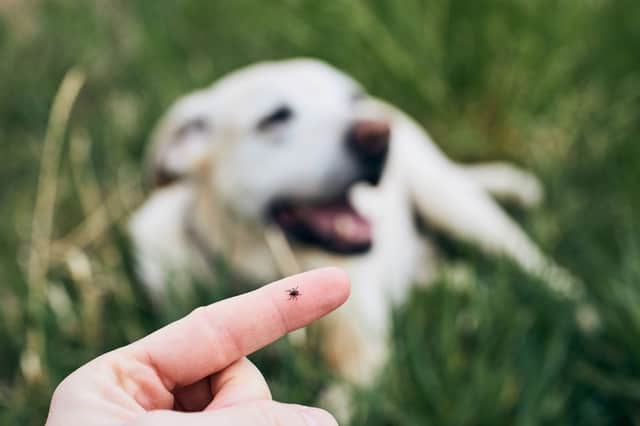Dogs and Ticks: How to stop your dog picking up a parasite - and what to do if they do


Tick Bite Prevention Week starts on Monday, March 24 - dedicated to increasing awareness of the hazards the parasites present.
To mark the occasion, Petsure veterinarian Dr. Hannah Godfrey, has shared her expert tips for how to prevent tick bites - plus how you can spot the symptoms of tick-borne diseases in dogs.
Here's what she had to say.
What is a tick?
Advertisement
Hide AdAdvertisement
Hide AdTicks are parasites that suck blood from their hosts and can pass on various dangerous diseases to our four-legged friends. You can recognise a tick by their oval-shaped bodies, and spider-like legs. They’re usually very small, less than one centimetre long, and can vary in colour but are often brown or white. Ticks bury their mouthparts deep into the skin of both animals and humans while they feed, then drop off when they’re full. When they’re done feeding, they become a dark grey/brown colour and are much larger in size.
When and where do you find ticks?
Ticks are common in woodland and grassland and are most active throughout the spring and summer.
Why are ticks dangerous?
Sadly, ticks can carry dangerous bacteria and parasites such as babesiosis, which can pass on to your pets. Babesiosis (the condition caused by the Babesia parasite) causes damage to the red blood cells and can lead to severe anaemia and even organ failure. One of the more common diseases transmitted by ticks in the UK is Lyme disease, which can lead to kidney failure in dogs. Early signs of Lyme disease include a lack of appetite, weight loss, and lethargy. Symptoms of Lyme disease can appear weeks or months after being bitten, at which point the disease could have spread throughout the body. Some tick bites can even cause paralysis in dogs. Symptoms of this usually appear three to nine days after the tick attaches itself. Paralysis typically starts with a loss of back leg coordination, followed by a change in breathing, vomiting or gagging, and a change or loss of bark. Speak to your vet as soon as possible if you think your pet is infected and they can give antibiotics and other treatment if needed. It’s worth bearing in mind that your pet insurance could also protect you from these unexpected vet bills.”
How can I prevent tick-spread diseases?
Check pets after walks
It’s good practice to do a tick check anytime your dog returns from outdoors. Run your hands over their body, making sure to focus on areas like their head and ears, belly, and armpits. Try to feel for any small bumps on their skin.
Use tick control products
There are plenty of products out there that can help prevent tick bites. Look out for collars, sprays, and spot-on treatments, but be sure to only use products recommended by your vet.
Never use tick control intended for cats on dogs, and vice versa
Tick treatment for dogs include chemicals that can be lethal for cats, and a treatment intended for cats may also be harmful to your dog. Your vet will recommend the right treatment for your specific pet.
Cut back the grass in your garden
While ticks are more common in woodland areas, they can also be found in your garden. Make sure to keep the grass and vegetation in your garden cut short to avoid harbouring ticks.
If you do discover a tick, remove it safely
It’s important to remove ticks as quickly as possible to prevent infection. The best way to do so is with a specific tick removal tool, so keep one with you when you go on walks. Whatever you do, don’t squeeze or crush the tick. This might leave part of the tick’s mouthparts in your pet’s skin, increasing the risk of infection.
Comments
Want to join the conversation? Please or to comment on this article.